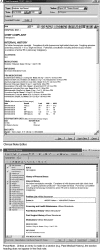Transition from paper to electronic inpatient physician notes
- PMID: 20064811
- PMCID: PMC2995621
- DOI: 10.1197/jamia.M3173
Transition from paper to electronic inpatient physician notes
Abstract
UW Medicine teaching hospitals have seen a move from paper to electronic physician inpatient notes, after improving the availability of workstations, and wireless laptops and the technical infrastructure supporting the electronic medical record (EMR). The primary driver for the transition was to unify the medical record for all disciplines in one location. The main barrier faced was the time required to enter notes, which was addressed with data-rich templates tailored to rounding workflow, simplified login and other measures. After a 2-year transition, nearly all physician notes for hospitalized patients are now entered electronically, approximately 1500 physician notes per day. Remaining challenges include time for note entry, and the perception that notes may be more difficult to understand and to find within the EMR. In general, the transition from paper to electronic notes has been regarded as valuable to patient care and hospital operations.
Conflict of interest statement
Figures

References
-
- Van Eaton EG, Horvath KD, Lober WB, et al. Organizing the transfer of patient care information: The development of a computerized resident sign-out system. Surgery 2004;136:5–13 - PubMed
-
- Jha AK, DesRoches CM, Campbell EG, et al. Use of electronic health records in US hospitals. N Engl J Med 2009;360:1628–38 - PubMed
-
- American Hospital Association Continued progress: hospital use of information technology. Chicago: American Hospital Association, 2007

